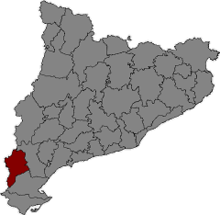Terra Alta (wine region)
The Denominación de Origen ( DO ) Terra Alta is a wine-growing region in the southwest of Catalonia. It is named after its geographical location, an approximately 740 km² highland region.
location
The area defined for the DO is identical to that of the Comarca Terra Alta in the south of the autonomous region of Catalonia , in the west of the province of Tarragona . In the west, Terra Alta borders the Aragon region , the northern border is formed by the Ebro . The DO includes the following 12 municipalities: Arnes , Batea , Bot , Caseres , Corbera d'Ebre , La Fatarella , Gandesa , Horta de Sant Joan , El Pinell de Brai , La Pobla de Massaluca , Prat de Comte and Vilalba dels Arcs .
history
The viticulture in this region can be up to the early Middle Ages are detected: legal texts of Las costums Orta from the year 1296 and of Miravet from the year 1319 be rules ago for viticulture and wine production.
In the 18th century, wine was grown on a large part of the agricultural area of Terra Alta, around 1900 more than 5000 hectares were planted with wine.
The white grape variety Garnacha Blanca was predominant. Wine was for local consumption and as a basis for cava and the traditional Catalan products Mistela and Vi Ranci generated.
With the Spanish Wine Law of December 1970 (ratified 1972) the protected designation of origin "Terra Alta" was introduced. The official recognition of the DO status and the creation of the control authority (Consejo Regulador) took place on May 28, 1982 by corresponding laws or by their confirmation on July 22, 1985.
Important changes to the regulations were made in July 1995 - above all, other grape varieties were authorized.
Today (as of 31/07/2006) about 1650 winegrowers cultivate 6500 hectares, wine is produced in 33 cellars . About equal parts of white and red wine are produced. 69% of the wine meet the DO requirements.
ground
The vineyards are between 350 and 500 m high. In general, the soils are of Quaternary origin, rich in limestone and with a loamy-clay structure. They are poor in organic materials and have good water storage capacity.
climate
The climate is Mediterranean with continental influences. The summers are long and hot with temperatures up to 38 ° C. In the cold winters the temperature can drop to -5 ° C. There is plenty of sunshine and rainfall of 350 to 500 mm / year (depending on the location). Two winds are characteristic and have a strong influence on viticulture - the dry north wind Cierzo and the cooling wind Garbí from the Mediterranean .
Wine
We recommend using the white varieties Garnacha Blanca , Macabeo and Parellada . Furthermore, Sauvignon Blanc , Moscatel de grano pequeño (Frontignan), Moscatel de grano grande (Alejandría), Chenin Blanc , Pedro Ximénez and Chardonnay authorized white grape varieties.
Garnacha Tinta , Garnacha Peluda and Samsó (Mazuela or Carignan) are the recommended red grape varieties. In addition, Tempranillo , Cabernet Franc , Cabernet Sauvignon , Merlot , Garnacha Tintorera and Syrah approved.
To achieve the DO status, the following minimum or maximum alcohol content must be observed:
White: 12.5% to 15% vol.
Rose: 12% to 15% vol.
Red: 12.5% to 15% vol.
Rancio , mistela and sweet wines : 15% to 20% vol.
Pearl and sparkling wine: 11% to 12.5% vol.
See also: Viticulture in Spain
literature
- John Radford: Wine Landscape Spain. Tradition and departure. Hallwag, Bern et al. 1999, ISBN 3-444-10553-3 .

